Page 1264 of 4087
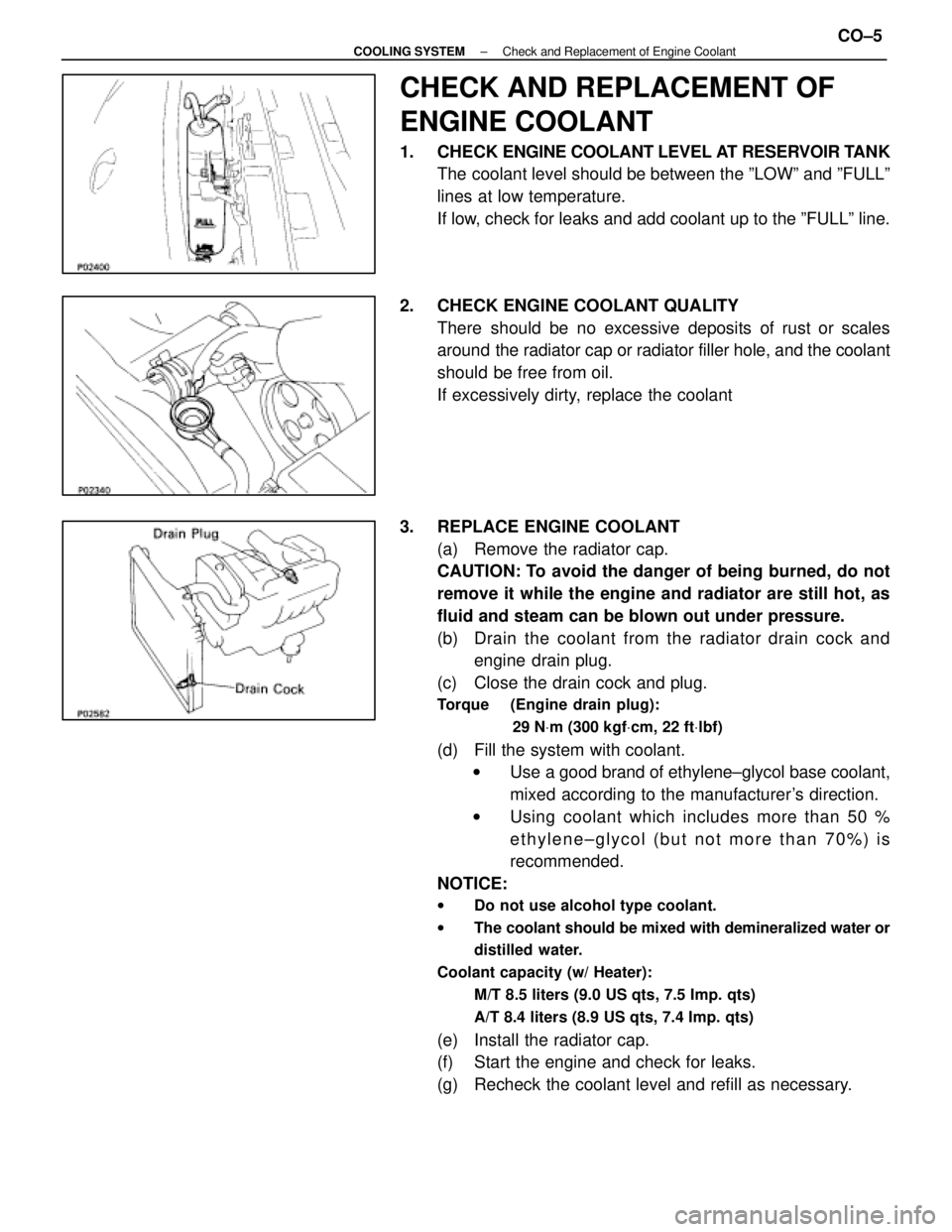
CHECK AND REPLACEMENT OF
ENGINE COOLANT
1. CHECK ENGINE COOLANT LEVEL AT RESERVOIR TANK
The coolant level should be between the ºLOWº and ºFULLº
lines at low temperature.
If low, check for leaks and add coolant up to the ºFULLº line.
2. CHECK ENGINE COOLANT QUALITY There should be no excessive deposits of rust or scales
around the radiator cap or radiator filler hole, and the coolant
should be free from oil.
If excessively dirty, replace the coolant
3. REPLACE ENGINE COOLANT (a) Remove the radiator cap.
CAUTION: To avoid the danger of being burned, do not
remove it while the engine and radiator are still hot, as
fluid and steam can be blown out under pressure.
(b) Drain the coolant from the radiator drain cock andengine drain plug.
(c) Close the drain cock and plug.
Torque (Engine drain plug):
29 NVm (300 kgf Vcm, 22 ft Vlbf)
(d) Fill the system with coolant.
w Use a good brand of ethylene±glycol base coolant,
mixed according to the manufacturer's direction.
w Using coolant which includes more than 50 %
ethylene±glycol (but not more than 70%) is
recommended.
NOTICE:
w Do not use alcohol type coolant.
w The coolant should be mixed with demineralized water or
distilled water.
Coolant capacity (w/ Heater): M/T 8.5 liters (9.0 US qts, 7.5 Imp. qts)
A/T 8.4 liters (8.9 US qts, 7.4 Imp. qts)
(e) Install the radiator cap.
(f) Start the engine and check for leaks.
(g) Recheck the coolant level and refill as necessary.
±
COOLING SYSTEM Check and Replacement of Engine CoolantCO±5
WhereEverybodyKnowsYourName
Page 1265 of 4087
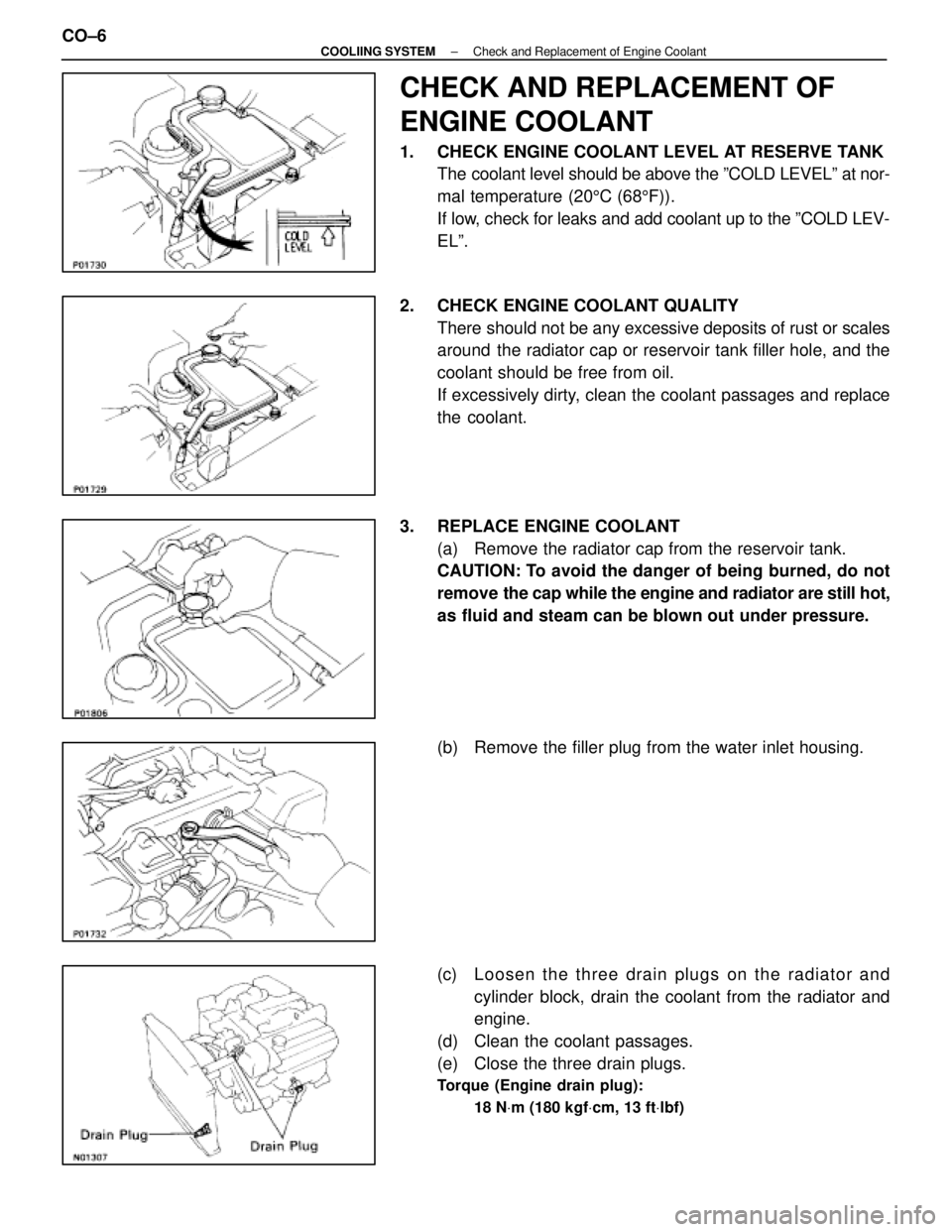
CHECK AND REPLACEMENT OF
ENGINE COOLANT
1. CHECK ENGINE COOLANT LEVEL AT RESERVE TANKThe coolant level should be above the ºCOLD LEVELº at nor-
mal temperature (20 5C (68 5F)).
If low, check for leaks and add coolant up to the ºCOLD LEV-
ELº.
2. CHECK ENGINE COOLANT QUALITY There should not be any excessive deposits of rust or scales
around the radiator cap or reservoir tank filler hole, and the
coolant should be free from oil.
If excessively dirty, clean the coolant passages and replace
the coolant.
3. REPLACE ENGINE COOLANT (a) Remove the radiator cap from the reservoir tank.
CAUTION: To avoid the danger of being burned, do not
remove the cap while the engine and radiator are still hot,
as fluid and steam can be blown out under pressure.
(b) Remove the filler plug from the water inlet housing.
(c) Loosen the three drain plugs on the radiator and
cylinder block, drain the coolant from the radiator and
engine.
(d) Clean the coolant passages.
(e) Close the three drain plugs.
Torque (Engine drain plug):
18 NVm (180 kgf Vcm, 13 ft Vlbf)
CO±6±
COOLIING SYSTEM Check and Replacement of Engine Coolant
WhereEverybodyKnowsYourName
Page 1283 of 4087
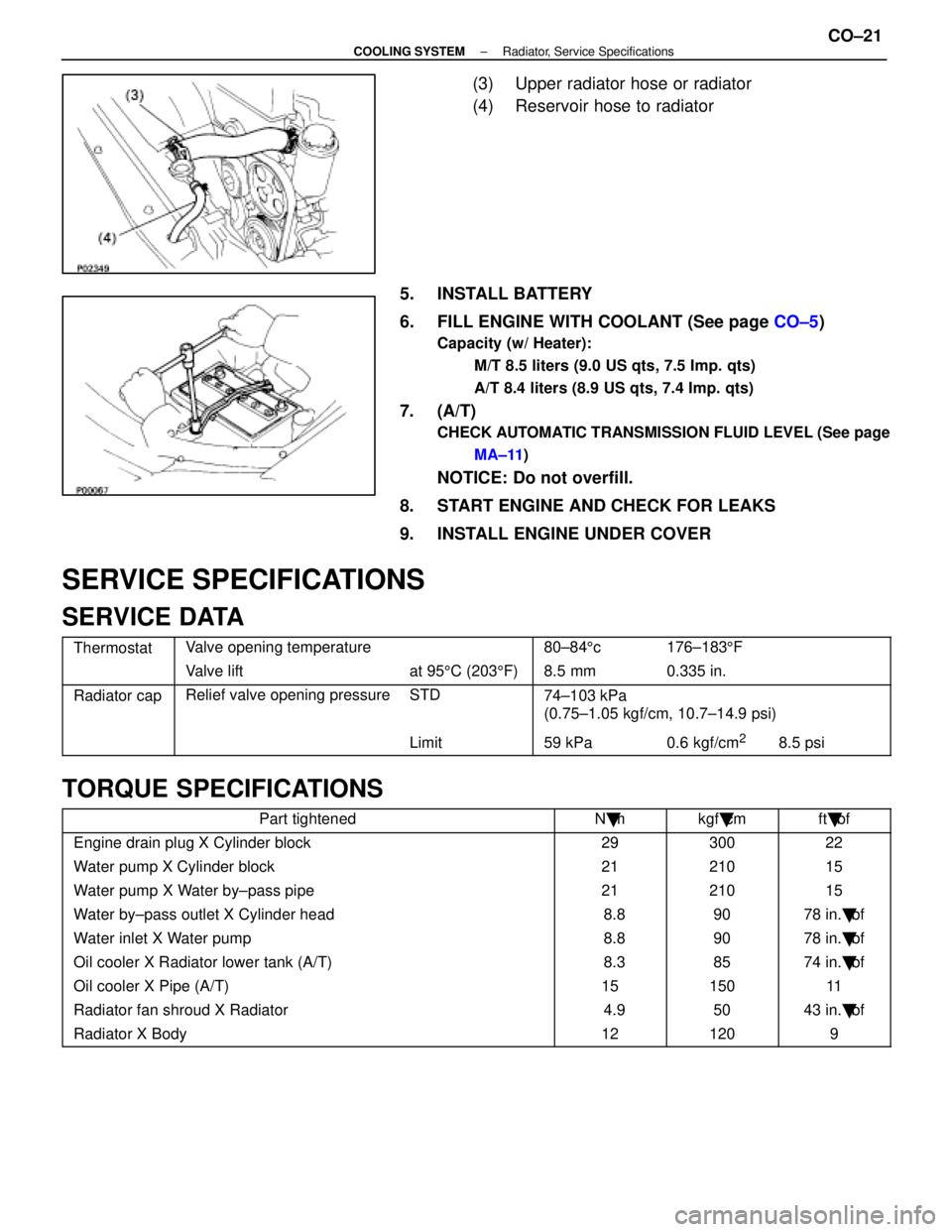
(3) Upper radiator hose or radiator
(4) Reservoir hose to radiator
5. INSTALL BATTERY
6. FILL ENGINE WITH COOLANT (See page CO±5)
Capacity (w/ Heater):
M/T 8.5 liters (9.0 US qts, 7.5 Imp. qts)
A/T 8.4 liters (8.9 US qts, 7.4 Imp. qts)
7. (A/T)
CHECK AUTOMATIC TRANSMISSION FLUID LEVEL (See pageMA±11 )
NOTICE: Do not overfill.
8. START ENGINE AND CHECK FOR LEAKS
9. INSTALL ENGINE UNDER COVER
SERVICE SPECIFICATIONS
SERVICE DATA
ThermostatValve opening temperature80±84 5c176±183 5F
Valve liftat 95 5C (203 5F) 8.5 mm0.335 in.
Radiator capRelief valve opening pressureSTD74±103 kPa
(0 75 1 05 k f/ 10 7 14 9 i)(0.75±1.05 kgf/cm, 10.7±14.9 psi)
Limit59 kPa0.6 kgf/cm28.5 psi
TORQUE SPECIFICATIONS
Part tightenedN �mkgf �cmft �lbf
Engine drain plug X Cylinder block2930022
Water pump X Cylinder block2121015
Water pump X Water by±pass pipe2121015
Water by±pass outlet X Cylinder head 8.89078 in. �lbf
Water inlet X Water pump 8.89078 in. �lbf
Oil cooler X Radiator lower tank (A/T) 8.38574 in. �lbf
Oil cooler X Pipe (A/T)1515011
Radiator fan shroud X Radiator 4.95043 in. �lbf
Radiator X Body121209
±
COOLING SYSTEM Radiator, Service SpecificationsCO±21
WhereEverybodyKnowsYourName
Page 1286 of 4087
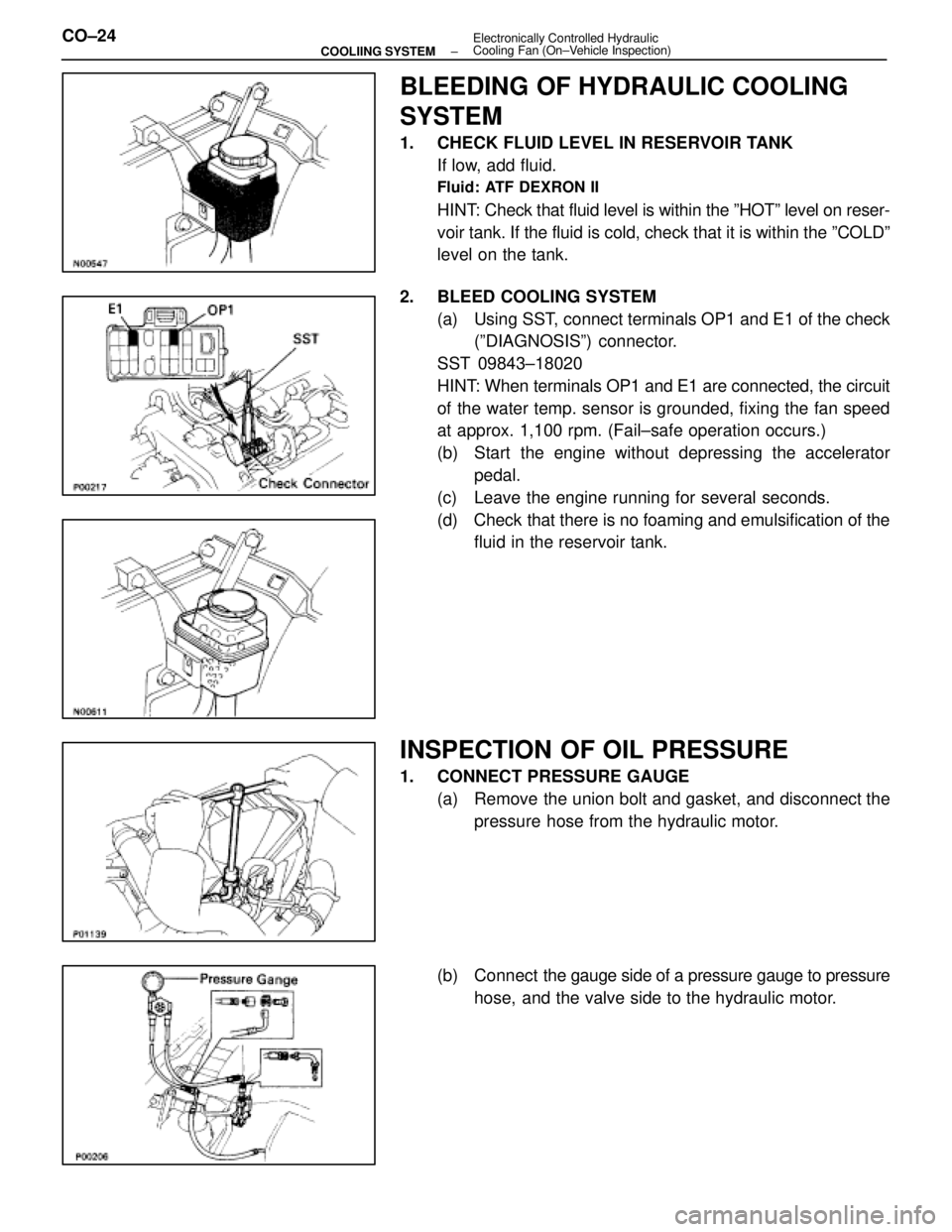
BLEEDING OF HYDRAULIC COOLING
SYSTEM
1. CHECK FLUID LEVEL IN RESERVOIR TANKIf low, add fluid.
Fluid: ATF DEXRON II
HINT: Check that fluid level is within the ºHOTº level on reser-
voir tank. If the fluid is cold, check that it is within the ºCOLDº\
level on the tank.
2. BLEED COOLING SYSTEM (a) Using SST, connect terminals OP1 and E1 of the check(ºDIAGNOSISº) connector.
SST 09843±18020
HINT: When terminals OP1 and E1 are connected, the circuit
of the water temp. sensor is grounded, fixing the fan speed
at approx. 1,100 rpm. (Fail±safe operation occurs.)
(b) Start the engine without depressing the accelerator pedal.
(c) Leave the engine running for several seconds.
(d) Check that there is no foaming and emulsification of the fluid in the reservoir tank.
INSPECTION OF OIL PRESSURE
1. CONNECT PRESSURE GAUGE
(a) Remove the union bolt and gasket, and disconnect thepressure hose from the hydraulic motor.
(b) Connect the gauge side of a pressure gauge to pressure
hose, and the valve side to the hydraulic motor.
CO±24
±
COOLIING SYSTEM Electronically Controlled Hydraulic
Cooling Fan (On±Vehicle Inspection)
WhereEverybodyKnowsYourName
Page 1287 of 4087
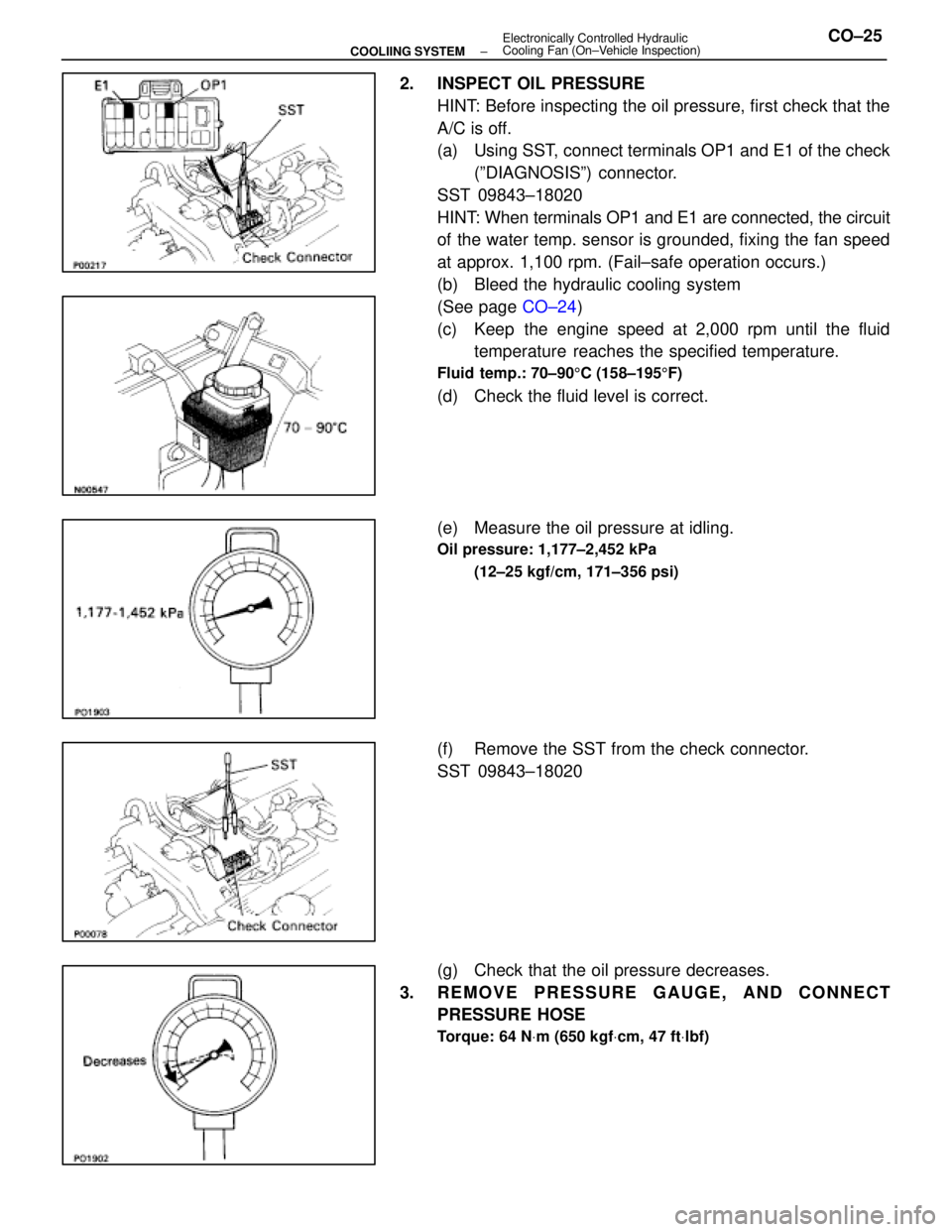
2. INSPECT OIL PRESSUREHINT: Before inspecting the oil pressure, first check that the
A/C is off.
(a) Using SST, connect terminals OP1 and E1 of the check(ºDIAGNOSISº) connector.
SST 09843±18020
HINT: When terminals OP1 and E1 are connected, the circuit
of the water temp. sensor is grounded, fixing the fan speed
at approx. 1,100 rpm. (Fail±safe operation occurs.)
(b) Bleed the hydraulic cooling system
(See page CO±24)
(c) Keep the engine speed at 2,000 rpm until the fluid temperature reaches the specified temperature.
Fluid temp.: 70±90 5C (158±195 5F)
(d) Check the fluid level is correct.
(e) Measure the oil pressure at idling.
Oil pressure: 1,177±2,452 kPa
(12±25 kgf/cm, 171±356 psi)
(f) Remove the SST from the check connector.
SST 09843±18020
(g) Check that the oil pressure decreases.
3. REMOVE PRESSURE GAUGE, AND CONNECT PRESSURE HOSE
Torque: 64 N Vm (650 kgf Vcm, 47 ft Vlbf)
±
COOLIING SYSTEM Electronically Controlled Hydraulic
Cooling Fan (On±Vehicle Inspection)CO±25
WhereEverybodyKnowsYourName
Page 1296 of 4087
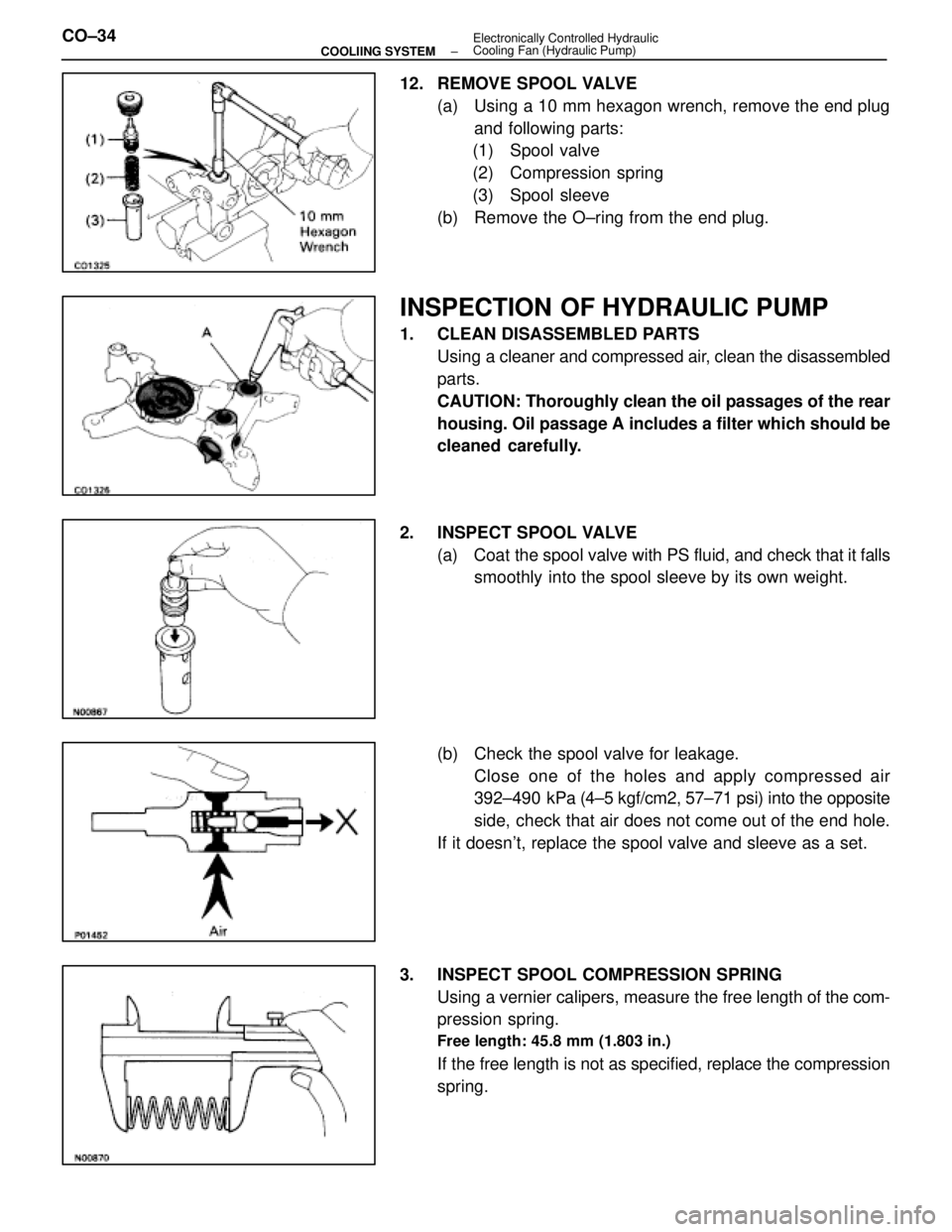
12. REMOVE SPOOL VALVE(a) Using a 10 mm hexagon wrench, remove the end plugand following parts:
(1) Spool valve
(2) Compression spring
(3) Spool sleeve
(b) Remove the O±ring from the end plug.
INSPECTION OF HYDRAULIC PUMP
1. CLEAN DISASSEMBLED PARTS Using a cleaner and compressed air, clean the disassembled
parts.
CAUTION: Thoroughly clean the oil passages of the rear
housing. Oil passage A includes a filter which should be
cleaned carefully.
2. INSPECT SPOOL VALVE (a) Coat the spool valve with PS fluid, and check that it falls
smoothly into the spool sleeve by its own weight.
(b) Check the spool valve for leakage. Close one of the holes and apply compressed air
392±490 kPa (4±5 kgf/cm2, 57±71 psi) into the opposite
side, check that air does not come out of the end hole.
If it doesn't, replace the spool valve and sleeve as a set.
3. INSPECT SPOOL COMPRESSION SPRING Using a vernier calipers, measure the free length of the com-
pression spring.
Free length: 45.8 mm (1.803 in.)
If the free length is not as specified, replace the compression
spring.
CO±34
±
COOLIING SYSTEM Electronically Controlled Hydraulic
Cooling Fan (Hydraulic Pump)
WhereEverybodyKnowsYourName
Page 1317 of 4087
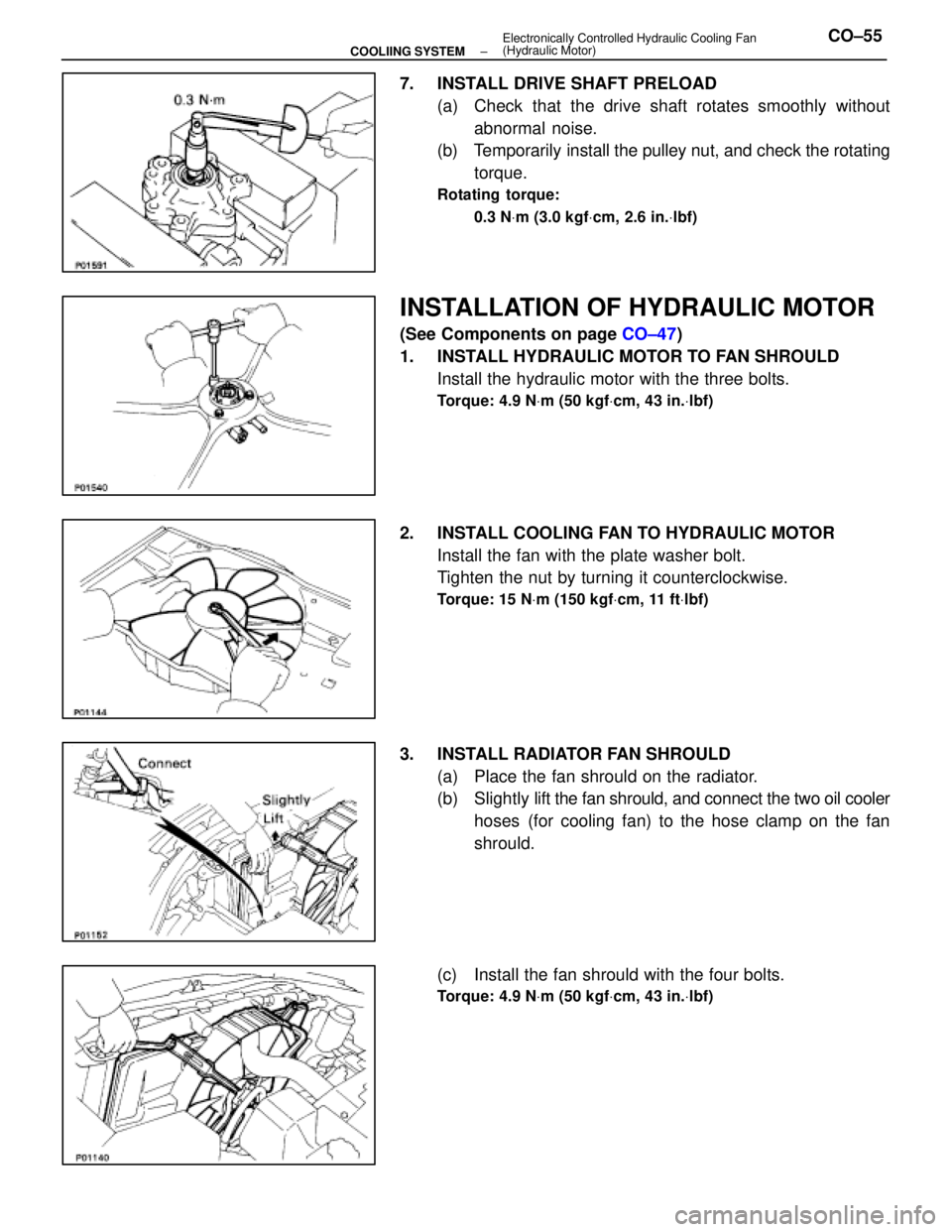
7. INSTALL DRIVE SHAFT PRELOAD(a) Check that the drive shaft rotates smoothly withoutabnormal noise.
(b) Temporarily install the pulley nut, and check the rotating
torque.
Rotating torque:
0.3 N Vm (3.0 kgf Vcm, 2.6 in. Vlbf)
INSTALLATION OF HYDRAULIC MOTOR
(See Components on page CO±47)
1. INSTALL HYDRAULIC MOTOR TO FAN SHROULD Install the hydraulic motor with the three bolts.
Torque: 4.9 N Vm (50 kgf Vcm, 43 in. Vlbf)
2. INSTALL COOLING FAN TO HYDRAULIC MOTOR
Install the fan with the plate washer bolt.
Tighten the nut by turning it counterclockwise.
Torque: 15 N Vm (150 kgf Vcm, 11 ft Vlbf)
3. INSTALL RADIATOR FAN SHROULD
(a) Place the fan shrould on the radiator.
(b) Slightly lift the fan shrould, and connect the two oil cooler
hoses (for cooling fan) to the hose clamp on the fan
shrould.
(c) Install the fan shrould with the four bolts.
Torque: 4.9 N Vm (50 kgf Vcm, 43 in. Vlbf)
±
COOLIING SYSTEM Electronically Controlled Hydraulic Cooling Fan
(Hydraulic Motor)CO±55
WhereEverybodyKnowsYourName
Page 1321 of 4087
4. REMOVE OIL COOLERRemove the three bolts and oil cooler.
INSPECTION OF OIL COOLER
INSPECT OIL COOLER
Check the oil cooler for damage or clogging.
If necessary, replace the oil cooler.
INSTALLATION OF OIL COOLER
(See Components on page CO±58)
1. INSTALL OIL COOLER Install the oil cooler with the three bolts.
Torque: 18 N Vm (180 kgf Vcm, 13 ft Vlbf)
2. CONNECT HOSES FROM OIL COOLER
Connect the following hoses:(1) Inlet hose (from reservoir tank)
(2) Outlet hose (from hydraulic motor)
3. INSTALL PS OIL COOLER Install the oil cooler with the two bolts.
4. REMOVE FENDER LINER
5. FILL COOLING FAN RESERVOIR TANK WITH FLUID
(See pages CO±23 and 24)
6. START ENGINE AND CHECK FOR LEAKS
±
COOLIING SYSTEM Electronically Controlled Hydraulic
Cooling Fan (Oil Cooler)CO±59
WhereEverybodyKnowsYourName